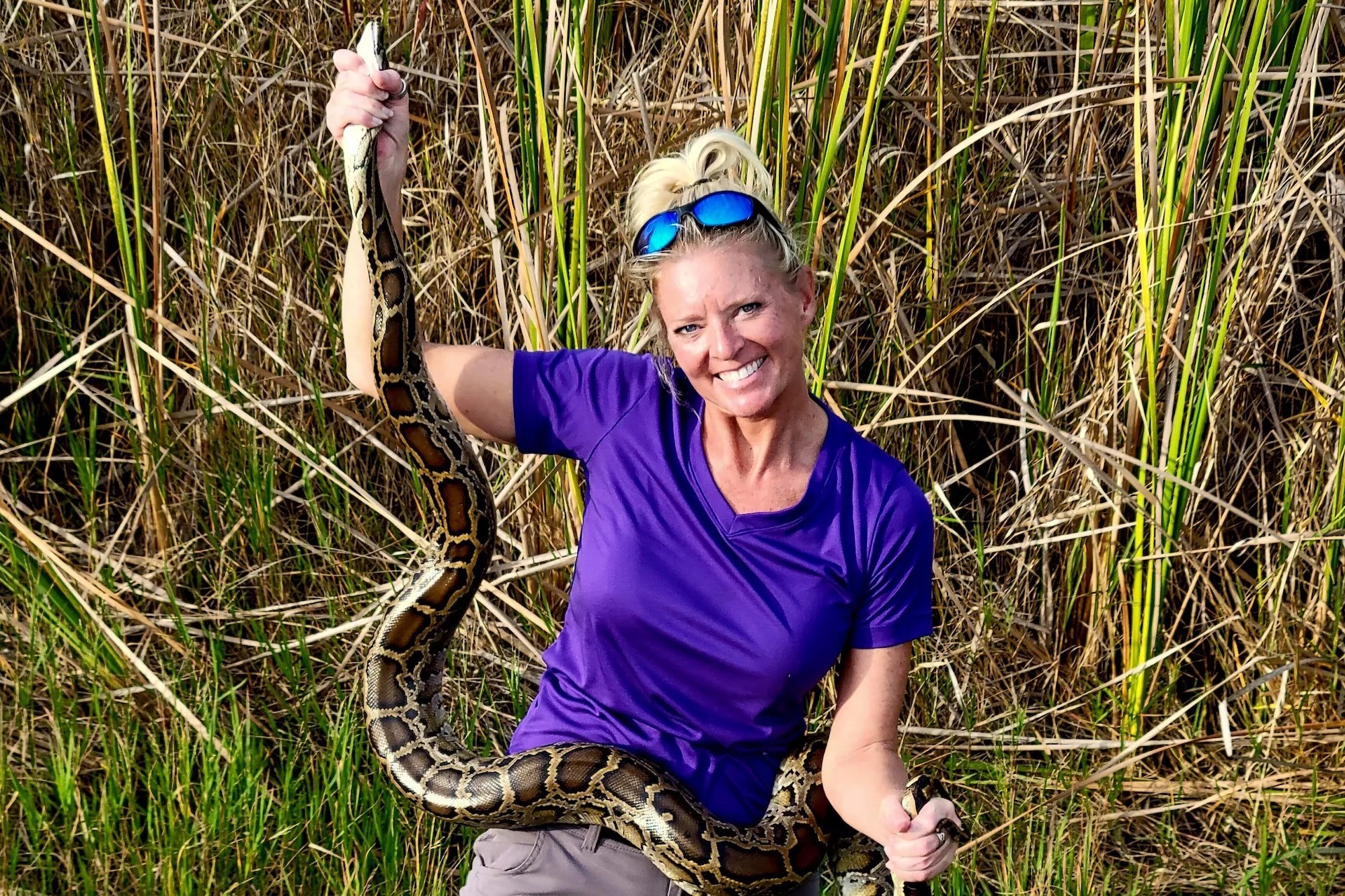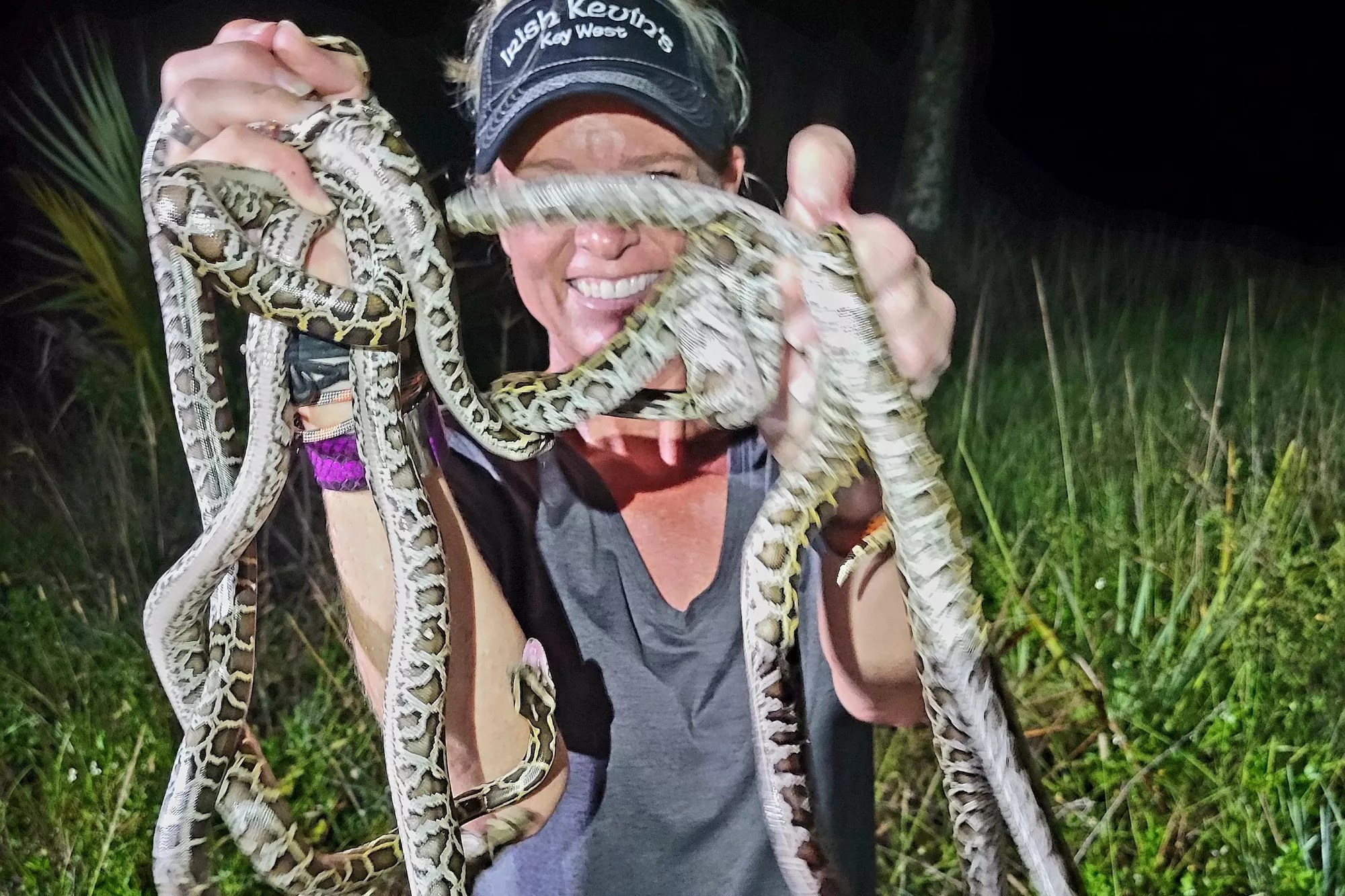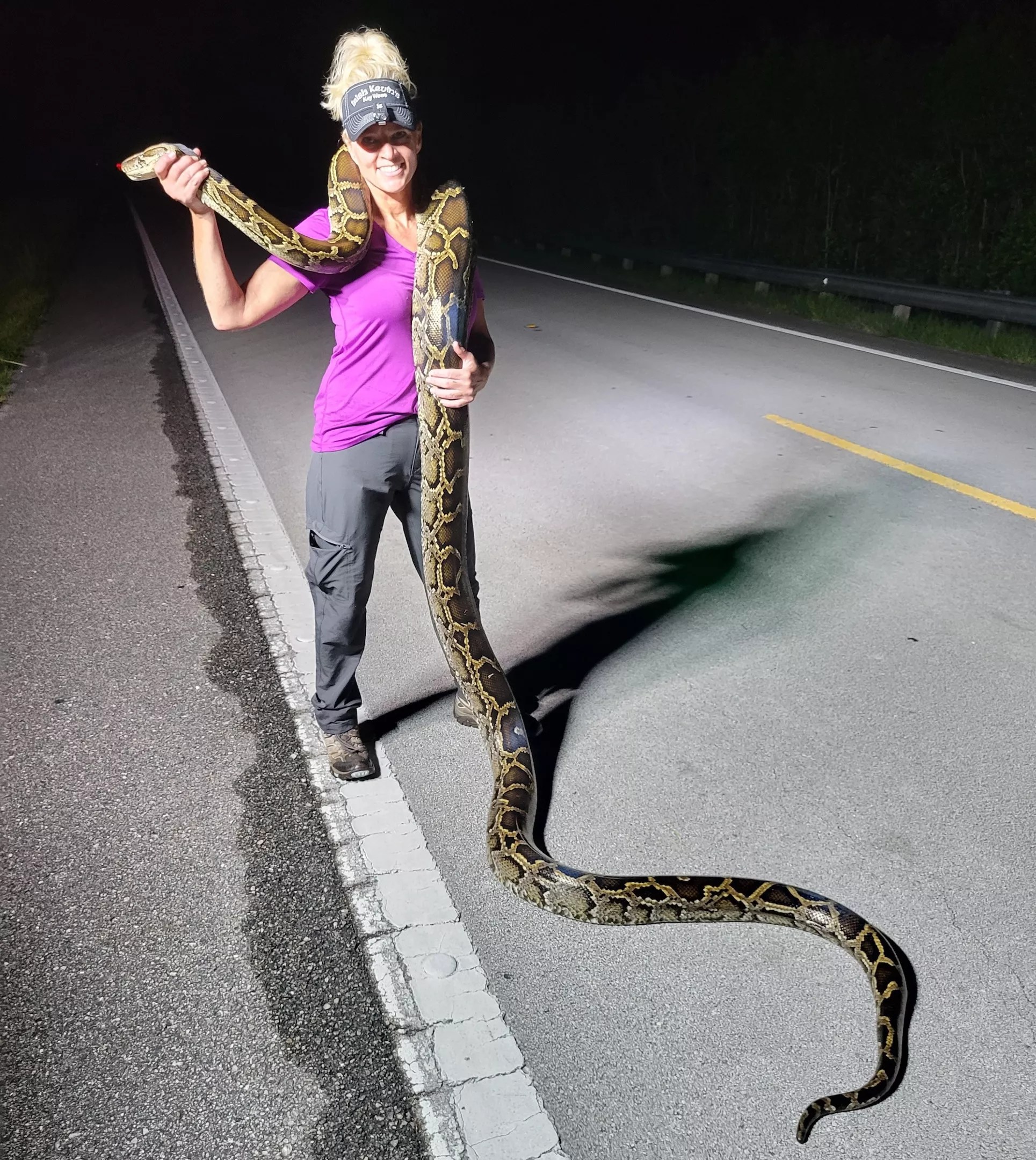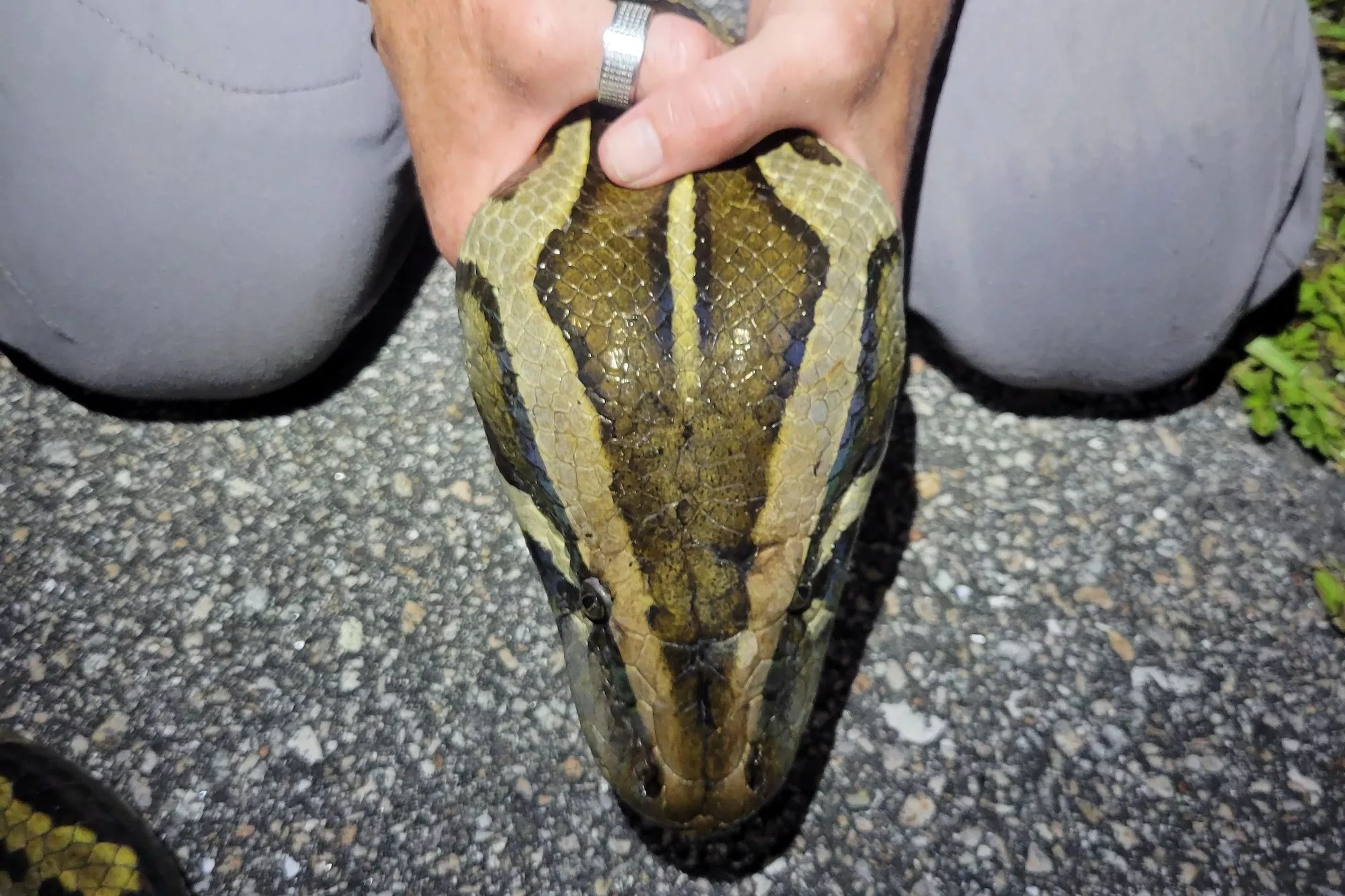
Photo by Dave Roberts

Audio By Carbonatix
It’s 10 p.m. on the fifth night of the 2023 Florida Python Challenge, and Amy Siewe is cruising nearly 11 feet above the pavement on her new “snake deck.” It’s a modified perch on the back of her white pick-up truck with elevated roll bars that have been tricked out with bright lights, cup holders, and cellphone cradles. Her fiancé, Dave Roberts, captains the vehicle at ten miles per hour as Siewe stands upright on the truck bed, her blond hair billowing in the wind.
“Hey, it’s the snake lady!” shouts a young man in a passing Honda Civic. Siewe shakes her head and continues to aim her spotlight along the road’s shoulder, waiting for the sudden sheen of squirming scales or a snake’s head periscoping out of the sawgrass to reveal itself to her.
“It took me a minute to learn what I was looking for,” says Siewe, her blue eyes fixed on the moving landscape. “The little nuances and patterns in the grass, the way that it shines a certain way.”
The sun has set, but the Everglades is still hot, sticky, and awake. Gnats and mosquitos flock to each exhale. Leopard and cricket frogs croon a croaky chorus in the slough. Marsh rabbits and cotton rats scurry along Tamiami Trail as invasive Burmese pythons attempt to cross it. Even though it’s a Tuesday night during the least hospitable time of the year, it’s the hunt for these elusive, slithering reptiles that can grow up to 20 feet in length that have scores of registered participants from all over the country out here in the muggy darkness for a chance to win $30,000 during the ten-day, state-sponsored python removal competition. After all, it’s the wet season, the nonbreeding period for pythons, when these critters can slither up to four miles in three days through the muck and, with a seemingly insatiable appetite, devour the mammals, birds, and other native wildlife in their path.
“Pythons spend most of their time not moving, so we have to get them when they’re on the move,” Siewe explains. “Ninety-five percent of this is right time, right place.”

“I got a family that chose python hunting over a Disney vacation,” Siewe says.
Photo by Dave Roberts
Hunter for Hire
In the four years since Siewe moved to South Florida from Indiana, where she worked as a real estate broker, she has caught more than 500 Burmese pythons, making her one of the most prolific and recognizable faces on the Everglades’ invasive snake-hunting scene. During the wet season, May through November, Siewe hunts up to five nights a week, from 8 p.m. to the wee hours before dawn. But after working for three years as a state python-removal contractor with the Florida Fish and Wildlife Conservation Commission (FWC) and later the South Florida Water Management District, a new demand in the swamp has forced Siewe to make yet another career pivot: Requests by tourists as far away as Germany have prompted the python assassin to resign from her $13-an-hour job to lead guided hunts that cost roughly $1,500 a trip.
“I have people that have gone on African safari hunts and other big-game hunts all over the world wanting to come here and catch pythons because they’ve never done it before,” she says. “One time, I got a family that chose python hunting over a Disney vacation.”
On a complimentary guided hunt with a New Times reporter, Siewe explained that she couldn’t guarantee a python capture – she never does. The night before, she had apprehended only a two-foot-long hatchling, which was still thrilling but far from the behemoth battle between man and massive constrictor that her adrenaline-seeking clients usually crave. Though she’s captured a few “deer eaters” (snakes measuring upwards of 16 feet) in her time, most pythons she encounters range from six to nine feet in length. In the previous two weeks, Siewe had captured 31 snakes, but since the Florida Python Challenge started on August 4, she hasn’t had much luck. Siewe has a growing suspicion that the pythons could somehow sense the sudden cavalcade of novice hunters lurching up and down Tamiami Trail for them.
“This is just speculation, but I think they’re sensitive to the vibrations on the road,” she says. “There’s still so much we don’t know about wild pythons.”

Siewe offers guided hunts to out-of-state travelers seeking to cross the “once-in-a-lifetime python hunt” off their bucket lists.
Photo by Dave Roberts
Scaling Up Her Business
Unlike most humans who evolved with an innate fear of snakes, Siewe has always been drawn to them. As a kid, she’d roam around the creek in Ohio with her dad, catching fish, turning over rocks for crawdads, and, if she were lucky, encountering a northern water snake, garter snake, ribbon snake, or her favorite, the black rat snake, which can grow to almost six feet long. In college, she volunteered at the Toledo Zoo’s herpetology department and managed an exotic pet store. After going into real estate, she bred corn and rat snakes as a hobby, sometimes looking after more than 50 snakes at a time. But after learning about the invasive Burmese python problem in South Florida, Siewe knew she had to experience it for herself.
“A rat snake is a very big snake there [in Indiana], but then you come here, and you’re just driving and have the opportunity to come across a 15-foot python,” she says. “That’s the Mack Daddy for a herper.”
In January 2019, Siewe went on her first hunt with state contractor Donna Kalil and caught a nine-foot python that first night. Siewe was hooked and, within two months, she had left her real-estate business in Indiana and rented a small room with a shared bathroom in Miami. Siewe would go out nearly every night in her Toyota Camry, hunting the Everglades for snakes, asking other hunters for advice, and honing her technique. By July 2019, she was hired by the FWC, earning an hourly wage and at least $50 for each snake she turned in. It was grueling, physical work that upended her diurnal lifestyle, but, Siewe says, it was her calling.
“I’ve handled captive pythons, but they’re just big blobs, not these mean, aggressive wild pythons,” she says. “It’s a different ballgame, but I knew I’d be really good at this because I’m not scared of snakes. I used this crazy passion that I have to make a difference and help Florida with this colossal problem.”
But the long nights, lack of sleep, and meager paycheck didn’t make python hunting feasible, at least not long-term. After repeated requests from out-of-state travelers seeking to cross the “once-in-a-lifetime python hunt” off their bucket lists, Siewe decided to leave her state-contracted position to offer guided hunts instead. During the dry season from December to April, Siewe takes clients out on her fiance’s boat by day to capture breeding pythons on the spoil islands. During the wet season from May to November, they patrol the roads by night for pythons on the move, typically either crossing the road or slithering alongside it.
“It was an incredible experience, and I don’t even like snakes,” says Laura Trent of Maryland, who went on a guided python hunt with Siewe earlier this month. Trent had wanted to plan a memorable trip for her husband’s 70th birthday with their two adult sons, and on the second night with Siewe, the family caught an eight-footer.
“I wanted to do something other than going out to a nice restaurant, something really special,” Trent says. “I understand eight-foot-two-inches is considered on the smaller side in the python world, but it really was such a rush of emotions for us. Now we want to go back and hopefully get one of those big girls that are 17 feet long.”
With billionaires launching themselves into space and the farthest depths of the oceans, criticism of extreme travel is growing, but python hunting in the Florida Everglades remains immune: not only does it benefit the local environment, it also draws tourists to the state during the slower, off-season.
“Seeing how it was an invasive species that was really devastating the native species in the Everglades definitely attracted us. We wanted to help out,” says Michael Asbury of Pennsylvania, who went on a guided hunt with Siewe in late July and caught a 12-footer. He’d been deer hunting plenty of times but had never caught a live animal before.
“Let’s just say it’s not for the faint of heart. You’re really proving yourself with the courage to jump on a snake,” Asbury says. “There’s adrenaline flowing, and you want to get close enough to make that pounce but not too close, so the snake gets nervous and does a strike response.”
Asbury has been back home for a month, but he’s already considering booking another hunt.
“I can certainly see how it’s addictive,” he says. “I’m ready to go again.”

Siewe does her best to salvage as much of the python as possible, tanning the hides and crafting Apple watch bands.
Photo by Dave Roberts
Last-Minute Catch
As the night wears on, the only snakes New Times encounters are the indigenous green water snakes that Siewe helps get across the road so they’re not inadvertently run over by the dozens of novice Python Challenge hunters patrolling Tamiami Trail. After little luck encountering an invasive snake, Siewe makes the executive decision to leave Big Cypress National Preserve and the Python Challenge boundaries. If we caught a python, she explains, it wouldn’t count toward the challenge. But Siewe already won the second-place prize for the longest snake during the 2020 Python Bowl. It’s not accolades that she’s seeking.
“I love to see how excited people are when they catch a snake,” she says. “I don’t care how much you like snakes or how much you’re not afraid of them. It’s still a big snake, and people are afraid, and then they muster up the courage while I’m talking them through it. And they grab it, and just the looks on their faces – it’s just out of this world!”
As we head west toward Naples on Tamiami Trail, Siewe sees it first. “Snake!” she hollers as she swings off the roll bar and closes in on the two-foot-long python hatchling slithering south across the road. She swiftly grabs the snake behind the neck and raises it triumphantly.
“It ate at least once,” she says, shaking her head.
After the photos are taken and the giddiness subsides, Siewe adheres to the FWC’s humane killing method, which calls for the constrictor to be immediately euthanized. She fires a bolt gun into its head and sticks a metal tool into the wound, pithing the snake and keeping it from regaining consciousness – a two-step process recommended by the American Veterinary Medical Association.
Siewe doesn’t enjoy this part but understands that there are 100,000 to 300,000 pythons roaming the Everglades, and she thinks of the marsh rabbits’ and white-tailed deer’s dwindling numbers. She does her best to salvage as much of the python as possible, tanning the hides and crafting the only Apple watch bands in the world that are made of invasive python skin. Once, she even delivered python meat to a Fort Myers chef who prepared python tacos and python lettuce wraps.
“It was amazing,” she says, “but just so chewy.”